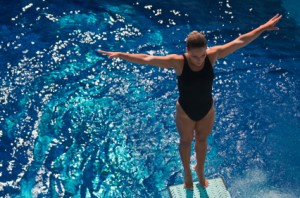 Currently, there is debate whether all events in the mind are predetermined by the brain’s molecular system. Many neuroscientists believe it is so. Another view is that much of the brain’s operation is unconscious, but there exists a free mind to initiate new activities or inhibit impulses. In this latter view the mind uses the brain circuits by exercising and building new skills.
Currently, there is debate whether all events in the mind are predetermined by the brain’s molecular system. Many neuroscientists believe it is so. Another view is that much of the brain’s operation is unconscious, but there exists a free mind to initiate new activities or inhibit impulses. In this latter view the mind uses the brain circuits by exercising and building new skills.
The Flinch Versus The Conscious Decision
Some objects, like the especially beautiful or dangerous, automatically grab our attention. This automatic attention is primed by primitive loops such as in the visual system where a signal is processed before it rises to the thinking cortex. There, it produces an automatic flinch. The reaction is more rapid than a process involving conscious thought, where there is a choice as to which stimulus deserves our attention.
Automatic Pilot Or Conscious Choice
In all situations where the senses of sight, sound, touch, smell and taste are flooding into our brain, analysis and reaction of the situation occurs either on auto-pilot or by conscious choice. When it is choice, it is from the variety of scattered thoughts and images flashing through our conscious mind. Conscious selective attention allows effective work, and produces excellence in fields such as academics, sports, and art. In a previous post meditation was shown to be useful to improve the brain circuits that support the ability to focus our attention.
Two prominent different mental decision-making systems are described in “Thinking Fast and Slow” (see Resources). The first is unconscious and rapid, based upon emotions, intuition, and previous experience. The second is slow, somewhat rational and difficult to focus.
There is also research which implies that negative emotions involve the slow rational process, with information processed more thoroughly, such as rumination when angry. The negative impressions, feelings, and feedback often have greater impact than good ones. They form quickly and last longer. People tend to recount the negative experiences more even if there are more positive ones to consider. Is it possible that survival required greater attention to bad situations? One theory implies that the good and bad information are processed in different cerebral hemispheres. Critical negative people are often viewed as smarter and when lecturing to “smarter people” they include more negative information. This line of research implies that it is important to teach children to deal with criticism as well as praise.
Brain Centers Are Stimulated By Use and Attention
Brain centers in the frontal lobe required for attention, if damaged, make it difficult to concentrate and focus attention. But even in damaged conditions, with training, the ability to focus can often be improved.
Normally, concentration on any particular sense or muscle group activates a brain center visible to functional magnetic resonance imaging (fMRI). The fMRI shows increases and decreases to the blood flow and metabolic activity of particular regions. They demonstrate that, for example, focusing on faces activates a specific visual circuit, and on hand movement a motor circuit.
Re-wiring the Brain
These circuits are not just activated, but with repeated active learning and practice, grow larger and stronger and spawn new circuits. Acts of memory and learning stimulate the production of new neurons that are integrated into the current brain circuits. Recent research has shown that the old and the very recent new neurons have distinct functions in connecting two different types of memory. Repeated use creates more connections between neurons, with more dendrites, axons, and synapses. When learning a new task multiple regions are activated to create the new circuit. More capable circuits are grown and solidified in any region of the brain where there is repeated focus of attention. This applies to a variety of fields: artists grow and connect visual regions of their brains, musicians their auditory regions, and athletes their motor regions.
Everyday Neuroplasticity
By focusing on a single activity, we re-wire our brains. In fact, cortical maps of the brain are changed in this process. Dramatic examples of this re-wiring occur in the newly deaf or blind. The visual and auditory brain regions change to accommodate the new, more frequently used sense. The brains of amputees change their body maps to accommodate new prosthetics. New wiring can change the purpose and function of neural circuits.
When something is well learned, such as a Bach sonata, a poem, the solution to a math problem, or a three-point basketball shot, brain activity moves from a learning center to a center for automatic activity. A common example is driving a car: we can be unconscious of our driving for long periods of time while still making decisions to slow down or change lanes. When something new and unusual occurs that requires more than an unconscious loop, the conscious process often takes over, hopefully in time to avoid an accident. When new learning is applied to already advanced skills, the original learning areas light up again until the new learning, too, becomes automatic. Even in ‘overlearned’ circuits, the brain can continue to change.
Attention is what changes and grows these brain circuits. In other words, the conscious choice to focus—a mental decision—can physically alter the brain.